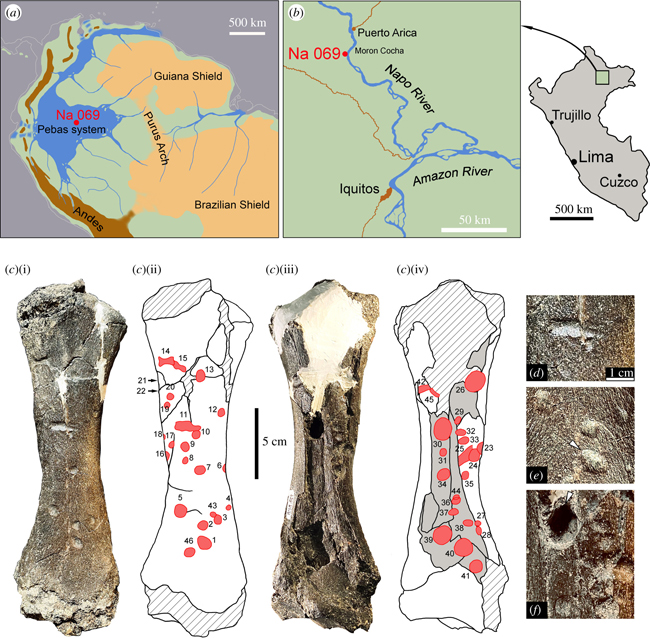New Study Suggests Ancient Crocodile Attacked Ground Sloths
Juvenile Purussaurus Attacked Ground Sloth
The giant prehistoric caiman Purussaurus is regarded as one of the largest crocodilians to have ever lived. How big this predator of the wetlands of South America during the Miocene actually was, remains open to debate. It is known mainly through skull material, (the largest measuring 1.45 metres in length) and isolated teeth. It is one of several types of crocodiles associated with the Pebas Mega-Wetland System from the north-western side of the continent. Evidence of Purussaurus interaction with prey is limited, confined to a scarred and dented turtle shell, documenting a failed attack by an adult Purussaurus.
Fossilised Tibia with Pathology
However, scientists have reported the discovery of the lower leg bone of a ground sloth that bears the tell-tale tooth marks and scratches of an attack from a Purussaurus (P. neivensis). The sloth identified as the genus Pseudoprepotherium very probably did not survive the encounter with a four-metre-long caiman.
A Life Reconstruction of the Purussaurus Attack

Picture credit: Jorge A. González
Attacked by a Juvenile Purussaurus
Thirteen million years ago, South America was an island continent. There was no isthmus joining the landmass to North America and therefore no opportunity for placental carnivores (Order Carnivora), to enter South America. There were terrestrial predators, such as pouched mammals from the marsupial lineage (sparassodonts) and three-metre-high terror birds (phorusrhacids). Competing with these creatures for the title of most feared predator was the prehistoric caiman Purussaurus neivensis and its close relatives.
Writing in “Biology Letters”, palaeontologist Rodolfo Salas-Gismondi from Cayetano Heredia University (Peru), along with co-author François Pujos conclude that the bitemarks on a tibia found during field work in north-eastern Peru represent predation by a four-metre-long, juvenile Purussaurus.
The Location of the Fossil Find and Views of the Damaged Tibia

Picture credit: Salas-Gismondi and François Pujos (Biology Letters)
The picture (above), shows the Pebas Mega-Wetland System around 13 million years ago (a). Na069 represents the bonebed where the tibia was found and (b) shows this bonebed location on the Napo River in north-eastern Peru. The left tibia of the ground sloth is shown in anterior (c i) and posterior (c ii) views with accompanying line drawings. Photographs (d-f) highlight individual toothmarks and punctures. The red dots map the bitemarks.
Extant and Extinct Crocodilian Skulls Compared Along with Purussaurus Teeth and Damaged Turtle Shell

Picture credit: Salas-Gismondi and François Pujos (Biology Letters)
The picture (above) shows dorsal views of an adult extant black caiman (Melanosuchus niger) skull (a) compared with the skull of a juvenile Purussaurus neivensis (b), facing the damaged ground sloth tibia. The skull of an adult P. neivensis (c) and teeth (d). The shell of the prehistoric turtle Podocnemis with a portion of the carapace missing attributed to a bite from a huge Purussaurus brasiliensis (tip of jaw in line drawing).
A Substantial Meal for a 4-metre Crocodilian
The interpretation of the damaged tibia as evidence of predation from Purussaurus neivensis provides a rare insight into prehistoric crocodilian/prey behaviour. It suggests that prior to reaching adult size, young individuals fed upon terrestrial mammals about the size of a capybara. The ground sloth is estimated to have weighed around 78 kilograms that’s the about the same as an adult human male. If a young Purussaurus could take down an sloth weighing as much as a man, it speaks volumes for that person’s chances if they ever would have met a fully grown Purussaurus.
To read an article commenting on contenders for the largest crocodile known to science: Which was the Largest Crocodilian of All Time?
Ancient Purussaurus from Venezuela had unique adaptations to help it move: Ancient Crocodilian Evolved Unique Specialisations Due to its Size.
Prehistoric crocodilians from Peru: Peruvian Paradise for Prehistoric Crocodiles.
The scientific paper: “Predation of the giant Miocene caiman Purussaurus on a mylodontid ground sloth in the wetlands of proto-Amazonia” by François Pujos and Rodolfo Salas-Gismondi published in Biology Letters.
The Everything Dinosaur website: Everything Dinosaur.

